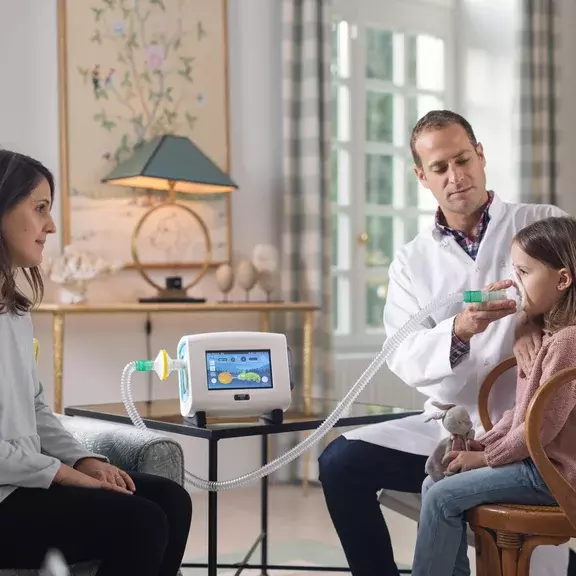Neuromuscular Diseases
We offer a complete solution that brings increased mobility and quality of life to patients.
What is a Neuromuscular Disease?
Although rare, neuromuscular diseases can arise at any stage of life, acquired or hereditary. Because it is often progressive, it affects other points in the peripheral nervous system. As a consequence, diseases such as: Amyotrophic Lateral Sclerosis, myopathies, radiculopathies, peripheral neuropathies, among others, can arise. It is a disease that significantly affects the quality of life of patients.
Neuromuscular diseases encompass a group of more than 200 pathologies that lead to generalised muscle weakness, involving upper and/or lower limbs, oropharyngeal and breathing muscles, causing difficulties in swallowing, speaking and breathing. They have different names depending on the involvement of the motor centre, and may progress to the inability to breathe spontaneously, requiring treatment with mechanical ventilation at home. There is no specific neuromuscular disease to receive this type of treatment. In general, they are diseases that progress with total or partial inability to perform breathing movement.
Neuromuscular diseases lead to the use of mechanical ventilation at home
Amyotrophic Lateral Sclerosis – ALS
ALS is one of the most well-known neuromuscular diseases also known as Motor Neurone Disease. It's a progressive neurological condition in which the nerves that control voluntary muscles stop working.
- There are currently more around 5000 people living with ALS in the UK(1,2)
- Around one in 30,000 people develops MND each year around the world
- About 1100 people are diagnosed every year in the UK(2)
- The median survival of these patients is three to five years
Secretion management (cough assist)
The loss of respiratory muscle strength in addition to hypoventilation also leads to the inability to remove secretions from the airways. In this case, bronchial hygiene can be performed using a cough assist machine which is a device that helps simulate a cough in order to clear secretions from the lungs. Indicated from mild to advanced stages of the disease.
High-tech equipment that guarantees a better quality of life.
Home Ventilators
With the progression of the disease and respiratory muscle weakness, there will be an increase in dependence on ventilatory support (>16 hours/day) and it is at this point that the use of life support equipment is suggested: mechanical home ventilators. These are capable of correcting changes in compliance and pulmonary resistance and are designed to work 24 hours a day.
Current models are light, portable, have an internal battery, can also be used for travel, school and other daily activities as they have a carry bag and/or can be attached to a wheelchair.
Safety during use
If you have any worries about the safe use of these devices please call our customer service team 0800 085 8398
- Keep the Ventilator or Cough assist on a flat and stable base.
- If provided and where possible use the roll stand for stability and safety
- Do not leave any ventilator accessories, such as the exhalation circuit and valve, on the seat/bed or other absorbent materials when not in use.
- Do not smoke in the environment where the ventilator and/or medical gas cylinder is installed.
- Do not use oils, fats or any substance to lubricate valves, regulators and connections.
- The ventilator must not be continually exposed to direct sunlight.
- When using the ventilator in transport please use the in-use carry bag.
- Do not keep liquids close to the inlet, device or its accessories in order to prevent the risk of electric shock.
- Handling of equipment should only be carried out by a qualified health professionals. Ventilator parameters must be prescribed by your clinical team and only adjusted by your HCP or clinical team.
- Alarms cannot be changed or turned off without direction of the physicians responsible for the patient. If you have any questions regarding alarms, contact Air Liquide Healthcare call centre on 0800 085 8398.
- Air Liquide Healthcare prohibits the performance of maintenance and repairs on the equipment by the customer/user.
- The ventilator must be used exclusively under the request of a physician and should not be used on any other person without a written prescription.
- The electrical installation must support the electrical power indicated on the equipment (see user manual).
- Use only external batteries or UPS supplied by Air Liquide Healthcare. Only ventilator and humidifier base must be connected to the UPS. It is prohibited to connect any other electronic equipment.
- When not in use the ventilator should always be connected to a power supply in order to prevent the internal battery from being discharged. If a UPS is used, the ventilator must remain connected to it, and likewise, the UPS must be connected to the mains.
- UPS – Check daily if the UPS is charged and connected to an electrical power point (other than a socket/extension strip) that is working properly.
References
(1) Opie-Martin S, Ossher L, Bredin A, Kulka A, Pearce N, Talbot K, Al-Chalabi A. Motor Neuron Disease Register for England, Wales and Northern Ireland-an analysis of incidence in England. Amyotroph Lateral Scler Frontotemporal Degener. 2021 Feb;22(1-2):86-93. doi: 10.1080/21678421.2020.1812661. Epub 2020 Sep 17. PMID: 32940088.
(2) https://www.nice.org.uk/guidance/qs126/documents/briefing-paper

